The Jewish communities in three cities alongside the Rhine – Speyer, Worms and Mainz – formed a unique and outstanding community alliance in medieval times. Since the 12th century, ShUM is not only an abbreviation of the three Hebrew city names Schpira, Warmaisa and Magenza, but also a trademark of the cities today. ShUM was the cradle of Ashkenazi Jewish culture during its formation, from the 11th century onwards. The ShUM communities were extremely innovative: The architecture of its synagogues influenced others across Europe, in ShUM the first ever-recorded women’s shuln was established and monumental ritual baths were built. Women and men alike are praised on the tombstones in the old Jewish cemeteries in Worms and Mainz, with no differentiation between genders. These cemeteries are the oldest in Ashkenaz and there, Jewish sepulchral culture was developed. Religious laws and religious decisions, known as Takkanot ShUM, were discussed by scholars from the three communities – and binding for Ashkenazi Jewish Culture for centuries. Still today, liturgical poetry and prayers from ShUM are sung in Synagogues.
Despite destructions, crusades, pogroms and massacres throughout the centuries, ShUM was a promised land among the diaspora. The communities were known as holy communities. The sites are still today spaces where Jews from all around the world connect to their heritage, both tangible and intangible. The monuments and cemeteries are iconographic spaces which are well known and therefore a journey to them is more significant than mere sightseeing. It is like a visit to the origins of Ashkenazi Judaism, to connect with heritage spanning over centuries.
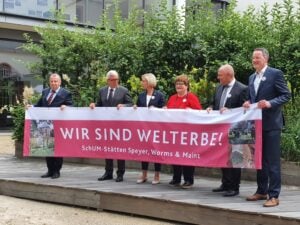
On July 27, 2021, UNESCO inscribed the “ShUM-Sites Speyer, Worms and Mainz” among the list of UNESCO World Heritage sites.
Let us take a closer look at the Worms’ Synagogue and also its reconstruction after the Shoah.
The first synagogue in Worms was built in 1034, as we know from the original Hebrew founder’s inscription. It is the oldest Hebrew inscription north of the Alps. The inscription names the founders, Jacob and Rachel, a childless couple who are praised in that what they did was “Better than sons and daughters / They shall remain remembered for good memory”. It is also said that the Worms’ synagogue is “the small sanctuary” – miqdash me’at –, in reference to the temple in Jerusalem as the large sanctuary. This seems positive, as a confirmation of God’s presence in exile. It can also be interpreted that a small temple is a limitation of God’s presence in exile. The term reflects the experience of exile as a restriction – and at the same time of great creativity and achievement, especially in SchUM.
A new Synagogue was built in 1174/75 as the first Synagogue was destroyed in the Crusades from 1096 onwards. The first two-span Synagogue ever known was built in Worms – in comparison to the usual Romanesque halls. The Bimah for Torah reading is situated between two columns dividing the inner space. These columns were another architectural revolution as they referred to the temple in Jerusalem and the two columns there, named in the bible Yahin (HE will raise up) and Boaz (In HIM is the power). This combination of two columns and the bimah at the centre were role models for the Synagogues of places such as Regensburg, Vienna, Prague and Krakow.
The Women’s shul, built in 1212/13, was donated by Judith and her husband Me’ir ben Joel. Judith herself was the daughter of Joseph, the founder of the mikveh (ritual bath) from 1186. The women’s shul is cross-vaulted over a central pillar. Listening windows in the wall assisted women to follow the main services – although they had their own female cantors and prayer leaders. With another reconstruction of the synagogue in 1355, after the plague pogrom in 1349, the women’s shul received gothic windows. The next devastating pogrom, in 1615, was followed again by a time of rebuilding and adapting. The new synagogue was re-opened only in September 1620. This reconstruction followed the Romanesque architectural form and also added the gothic and new architectural elements that we know today. A new entrance with a small community hall on the upper floor was also added to the front of the women’s shul. The facade formed the new representative north view of the synagogue district. In addition, the famous Rashi-Yeshiva, named after the scholar who had studied in Mainz and Worms in the 11th century, was built as an annex to the synagogue. Further changes of the substance followed in the renovations after the city fire in the Palatinate War of Succession in 1689. After this, the interior became much more baroque.
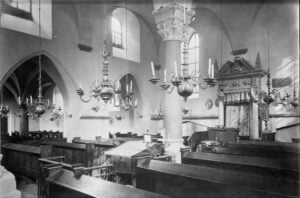
From then on until 1938, no more destruction swept over the time-honoured synagogue compound. The synagogue reform movement of the nineteenth century left its own mark: an inscription of 1842 reported with pride on opening the wall between the synagogue and the women’s shul in order to enable women to participate freely in the synagogue services. The traditional seating arrangement along the walls and around the Bimah was abandoned. The gothic Bimah was replaced by a new one. In the 1860s, the community installed, against a minority opinion, an organ in the synagogue. Because of this, orthodox members of the community erected their own synagogue, not more than 50 metres apart from the façade of the women’s shul. On Shabbat and High holidays, the community nevertheless gathered in the old, time-honoured synagogue.
In 1934, the 900th year of the first Worms Synagogue was commemorated. Letters from the Jewish world streamed in, from Budapest to New York and from many German-Jewish communities. They mirror what the Worms’ community meant to the Jewish world because of its long-lasting tradition and the clear signs of resilience and of feeling home. Leo Baeck, head of Germany’s Jewish community, who held the main speech in June 1934, underlined: “Nine centuries of such a house of prayer means also fatherland. A covenant was created: between this space and fatherland, between home country and spirituality.”
As the wave of destruction swept over the German Reich around November 9, 1938, the Worms Synagogue was not spared, it burnt for two nights. Lost were its valuable interior from the 13th century onwards, Torah Scrolls, furniture, a small Jewish museum and its over 180 objects.
After autumn 1939, the remaining walls and entrances of the Synagogue and its annexes were further destroyed. As the rubble was piling high, much of the original building material, enclosing ornamental fragments or the entrance portals, was sheltered within the debris. After this, Friedrich Maria Illert, City archivist and since 1934 director of the City’s Cultural Institutions stepped onto the scene. Immediately after the November Pogrom, Illert put all of his efforts into saving architectural fragments, objects and documents from the rubble – everything he was able to lay his hands on. In the aftermath of WWII, Illert, on this ground, depicted himself as the saviour of the Jewish past in Worms. Illert was, before and after 1945, an influential enthusiast for the city’s cultural heritage as the “oldest City of Germany” and the Nibelung legends. He included the Jewish monuments in his view on Worms – not as Jewish places but as a mere reflection of German culture. After 1945, he never said one word about the deported and murdered Jews of Worms. In 1945, the rubble was piling high and the streets of Worms was empty of Jews. Around six Jews lived in Worms at that time, having survived in so-called “mixed marriages”. In 1945/6, Jewish Displaced persons started to visit Worms, the ruins, and the still intact Cemetery Holy Sand, where numerous Rabbis and other renowned Jews are buried. In 1946, the Yiddish paper Frayhayt wrote: “The ruins of Worms and the destroyed Warsaw together represent … the destruction of all European Jewry.”
Then an initiative started to rebuild the synagogue in Worms. Illert was moving through the rubble, building up the entrance portal of the synagogue in 1948/9.
In a letter in 1947, he addressed various politicians and state administrations: “Since I was outside the Nazi-party and had no knowledge of the events within the party, I do not know whether and on what grounds the destruction of the synagogue was ordered. All I can say is that after the demolition of the walls in 1942, I was not prevented from picking out all the inscriptions, portals, window-wraps, and the Rashi-chair from the ruins and bringing them to the museum.”
This was self-made white-washing.
Only in 1949, a wall was built around the destroyed synagogues compound. It was built after a visit by the Jewish Restitution Organization. Representatives had underlined in a report that nothing was done to shelter the ruins.
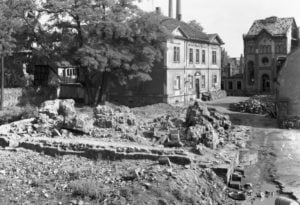
Illert in 1947 contacted Isidor Kiefer who, until his emigration to the US in 1933, was a member of the board of the Jewish community. Illert presented himself as a trustee for the Jewish Heritage in Worms. He was never designated as such, neither by the last Jews of Worms nor by the Reichsvereinigung, which was the implemented directorate of all communities after 1939. Regardless, Isidor Kiefer gratefully took up the initiative and supported strongly the reconstruction of the Synagogue. He had lost his status, his home, his country, and he longed for Warmaisa. Both, Illert and Kiefer, did not consider the Jewish community in Worms as legally extinct, but rather still alive, but in exile. Illert did this because his aim was to reconstruct medieval Worms and Kiefer because he was not able to face the abyss of destruction. There is no proof that Illert and Kiefer even knew each other personally before 1933 – what makes the story even more complicated.
Kiefer insisted that the reconstruction of the synagogue was central for the Jewish world in general and he started a signature collection in mid-1955 for supporting the reconstruction, using a form produced by Illert. Illert and Kiefer also reached out to politicians: the city administration of Worms, as well as the federal and the national governments. There were also voices from exiled Jews who did not support the reconstruction. One example of this was Ferdinand and Carola Kaufmann who wrote: “Incidentally, a synagogue should only be there where it serves its original purpose and where ten Jews unite for prayer. … the Worms community no longer exists”.
A letter from the City of Worms to the Federal Office for Preservation of Heritage from 1958 exposes a more than ambiguous motivation: “The resurrection of this synagogue in Worms could be regarded as sufficient in the sense of the reparation idea, which is the primary basis of … the reconstruction plan.”
Since February 1949, the small, newly established Jewish Community in Mainz – around 80 individuals – was responsible for the Jewish Communities alongside the left bank of the River Rhine – including the handful of Jews in Worms.
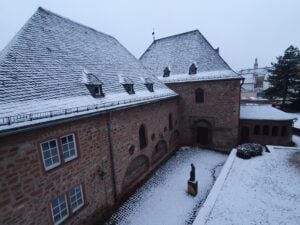
Prominent intercessors such as Chancellor Konrad Adenauer or Federal President Theodor Heuss turned the balance for the rebuilding of the Worms Synagogue. A letter from Kiefer to Adenauer in March 1954 was, in my opinion, the crucial turning point. “The writer of these lines was a machine manufacturer in Worms before emigrating as a result of anti-Semitic events. … A few days ago, the American Newspapers, especially the N.Y. Times, wrote about your suggestion regarding further reconciliation between Germany and the United States… I would like to contribute to this attitude of reconciliation and as a gesture towards the Jews who experienced such an injustice in the past and ask for the immediate reconstruction of the over 900-year old synagogue in Worms… I mention briefly that the synagogue coincides with the Worms Cathedral that was built in the 11th century.” The Chancellors administration answered that his suggestion would be, with great sympathy, considered and discussed.
Kiefer wrote to the Minister of the Interior in 1955. The result was an intensification of the debates and negotiations between the parties participating – although the Jewish community in Mainz was more or less overlooking the scenery from the sideline. In 1955, the Council for Monuments Preservation agreed to the reconstruction. In 1957, the compound was cleared of rubble. A huge amount of the original material for the reconstruction came out of the debris. The Foundation stone was laid on September 29, 1959.
A reply to another letter from Kiefer in November 1958 to the Chancellery underlined that the reconstruction of the synagogue “is of special interest to Chancellor Adenauer.” The synagogue was reconstructed with small adaptations to the modern style in the 1950s – and the organ was not reinserted. On the 3rd of December, 1961, the new-old Worms’ synagogue was opened. Isidor Kiefer passed away on October 16 of the same year.
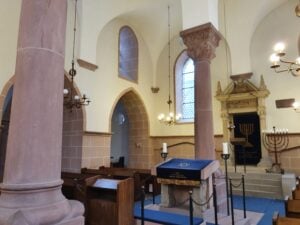
Numerous prominent visitors and guests attended the opening ceremony in 1961. Exiled Jews arrived to Worms. Many institutions and individuals had assisted in buying objects such as prayer books, wooden benches, etc. to make the synagogue ready for services. German police were present and watched over the ceremony – something very different compared to 1934.
The head of the Mainz Jewish community is the owner of the Compound although the city of Worms is still legally the trustee, as the Jewish Community does not have enough financial and human resources to maintain the building.
Up to the 1980s, the structure was, at first glance, more or less a museum, a space visited by tourists. They often perceived the synagogue as a symbol for reconciliation. Until the mid-1990s, Jewish visitors left remarks in the visitor book that it was a wonderful place but empty of “Jewishness” and a space where ghosts lived.
In the 1990s, through immigration from the former Soviet Union, Jews began to arrive in Germany. Jews started to build their lives in Worms and Mainz. The Worms Synagogue started to change: the former women’s shul is now a vivid space where cultural events, concerts, exhibitions and commemoration on the Shoah takes place. The Synagogue itself is used as a religious space. The Jewish community’s head today is a woman. Life has returned to the Jewish religious heritage of SchUM.
It was unique and also ambiguous to rebuild a synagogue in Post-Shoah times without a community and based partly on the indistinct idea of “Wiedergutmachung”.
However, I am sitting at my desk and looking directly from my office down to the synagogue and I can see that it has changed again – into a living heritage, a Jewish heritage with a living Jewish community. Jewish chants and prayers can be heard again, drifting on Shabbat or other holidays, through the old alleys of Worms.
Credit to: Dr Susanne Urban, Worms, Germany 2021 – Taken from: https://www.frh-europe.org/constantly-rebuilt-the-worms-synagogue-a-space-of-belief-trauma-and-resilience/

